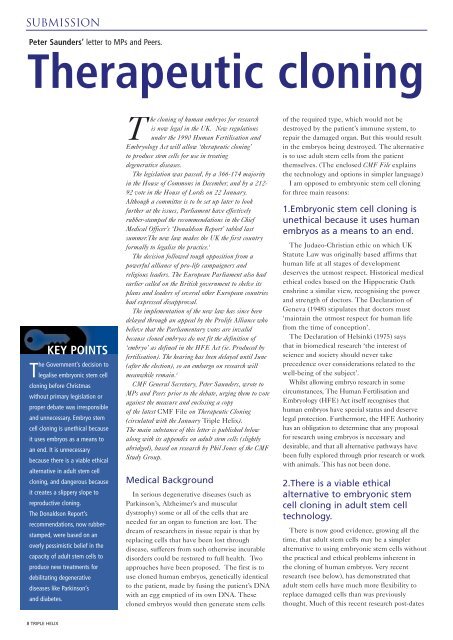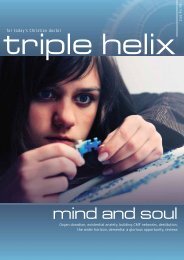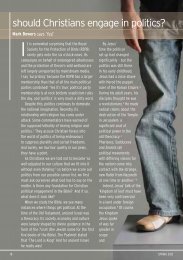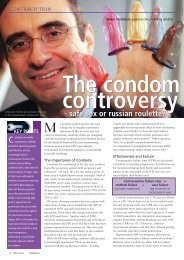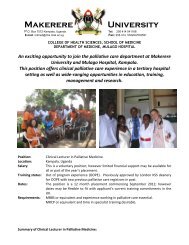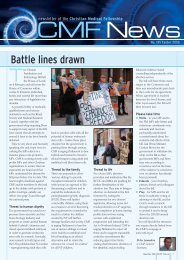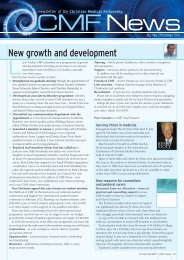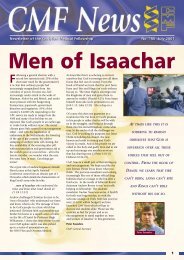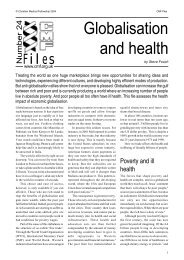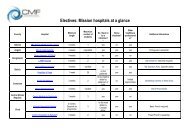Therapeutic cloning - Christian Medical Fellowship
Therapeutic cloning - Christian Medical Fellowship
Therapeutic cloning - Christian Medical Fellowship
You also want an ePaper? Increase the reach of your titles
YUMPU automatically turns print PDFs into web optimized ePapers that Google loves.
SubmissionPeter Saunders’ letter to MPs and Peers.<strong>Therapeutic</strong> <strong>cloning</strong>KEY POINTSThe Government’s decision tolegalise embryonic stem cell<strong>cloning</strong> before Christmaswithout primary legislation orproper debate was irresponsibleand unnecessary. Embryo stemcell <strong>cloning</strong> is unethical becauseit uses embryos as a means toan end. It is unnecessarybecause there is a viable ethicalalternative in adult stem cell<strong>cloning</strong>, and dangerous becauseit creates a slippery slope toreproductive <strong>cloning</strong>.The Donaldson Report’srecommendations, now rubberstamped,were based on anoverly pessimistic belief in thecapacity of adult stem cells toproduce new treatments fordebilitating degenerativediseases like Parkinson’sand diabetes.The <strong>cloning</strong> of human embryos for researchis now legal in the UK. New regulationsunder the 1990 Human Fertilisation andEmbryology Act will allow ‘therapeutic <strong>cloning</strong>’to produce stem cells for use in treatingdegenerative diseases.The legislation was passed, by a 366-174 majorityin the House of Commons in December, and by a 212-92 vote in the House of Lords on 22 January.Although a committee is to be set up later to lookfurther at the issues, Parliament have effectivelyrubber-stamped the recommendations in the Chief<strong>Medical</strong> Officer’s ‘Donaldson Report’ tabled lastsummer.The new law makes the UK the first countryformally to legalise the practice. 1The decision followed tough opposition from apowerful alliance of pro-life campaigners andreligious leaders. The European Parliament also hadearlier called on the British government to shelve itsplans and leaders of several other European countrieshad expressed disapproval.The implementation of the new law has since beendelayed through an appeal by the Prolife Alliance whobelieve that the Parliamentary votes are invalidbecause cloned embryos do not fit the definition of‘embryo’ as defined in the HFE Act (ie. Produced byfertilisation). The hearing has been delayed until June(after the election), so an embargo on research willmeanwhile remain. 2CMF General Secretary, Peter Saunders, wrote toMPs and Peers prior to the debate, urging them to voteagainst the measure and enclosing a copyof the latest CMF File on <strong>Therapeutic</strong> Cloning(circulated with the January Triple Helix).The main substance of this letter is published belowalong with its appendix on adult stem cells (slightlyabridged), based on research by Phil Jones of the CMFStudy Group.<strong>Medical</strong> BackgroundIn serious degenerative diseases (such asParkinson’s, Alzheimer’s and musculardystrophy) some or all of the cells that areneeded for an organ to function are lost. Thedream of researchers in tissue repair is that byreplacing cells that have been lost throughdisease, sufferers from such otherwise incurabledisorders could be restored to full health. Twoapproaches have been proposed. The first is touse cloned human embryos, genetically identicalto the patient, made by fusing the patient’s DNAwith an egg emptied of its own DNA. Thesecloned embryos would then generate stem cellsof the required type, which would not bedestroyed by the patient’s immune system, torepair the damaged organ. But this would resultin the embryos being destroyed. The alternativeis to use adult stem cells from the patientthemselves. (The enclosed CMF File explainsthe technology and options in simpler language)I am opposed to embryonic stem cell <strong>cloning</strong>for three main reasons:1.Embryonic stem cell <strong>cloning</strong> isunethical because it uses humanembryos as a means to an end.The Judaeo-<strong>Christian</strong> ethic on which UKStatute Law was originally based affirms thathuman life at all stages of developmentdeserves the utmost respect. Historical medicalethical codes based on the Hippocratic Oathenshrine a similar view, recognising the powerand strength of doctors. The Declaration ofGeneva (1948) stipulates that doctors must‘maintain the utmost respect for human lifefrom the time of conception’.The Declaration of Helsinki (1975) saysthat in biomedical research ‘the interest ofscience and society should never takeprecedence over considerations related to thewell-being of the subject’.Whilst allowing embryo research in somecircumstances, The Human Fertilisation andEmbryology (HFE) Act itself recognises thathuman embryos have special status and deservelegal protection. Furthermore, the HFE Authorityhas an obligation to determine that any proposalfor research using embryos is necessary anddesirable, and that all alternative pathways havebeen fully explored through prior research or workwith animals. This has not been done.2.There is a viable ethicalalternative to embryonic stemcell <strong>cloning</strong> in adult stem celltechnology.There is now good evidence, growing all thetime, that adult stem cells may be a simpleralternative to using embryonic stem cells withoutthe practical and ethical problems inherent inthe <strong>cloning</strong> of human embryos. Very recentresearch (see below), has demonstrated thatadult stem cells have much more flexibility toreplace damaged cells than was previouslythought. Much of this recent research post-dates8 TRIPLE HELIX
Submissionthe Donaldson Report, whichrecommended the use of embryonic stemcells and was accepted by the governmentlast summer.3. <strong>Therapeutic</strong> <strong>cloning</strong>will lead inevitably toreproductive <strong>cloning</strong>.Once cloned embryos have beenproduced, theoretically all that is necessaryfor reproductive <strong>cloning</strong> to take place is forthem to be implanted in a womb. Thisprocess is technically straightforward andwould be impossible to police.<strong>Therapeutic</strong> <strong>cloning</strong> of embryos thereforeconstitutes a very slippery slope toreproductive <strong>cloning</strong>.The case for the use of Adultstem cells in Tissue RepairAdult stem cells are cells that replacecells lost from a tissue throughout life.A single blood stem cell can replace theentire blood system in an animal whosebone marrow has been destroyed. 3 Untilvery recently the accepted dogma was thatin adults stem cells were programmed togenerate cells of a single tissue type. Forexample, blood stem cells 4 could generateblood cells, but not brain or muscle cells.Only embryonic stem cells were thoughtto have the ability to produce differenttissue types. It is now clear that this is notthe case. 5In papers in Science published inDecember 2000, two research groups (fromStanford University and the US NationalInstitute of Neurological Disorders andStroke) showed that blood stem cells couldgenerate nerve cells in the brain, whentransplanted into mice. 6,7 The blood cells,which had been genetically engineered tofluoresce green, did not need to be injectedinto the brains of the animals, but migratedinto the brain after intravenous injection.The authors of both papers stressed thatthese observations offered the hope of brainrepair from adult blood stem cells.Similar research reported in 1999demonstrated the potential of blood stemcells to repair damaged muscle in musculardystrophy. 8 Mice with a similar disorder tohuman muscular dystrophy were treatedwith a bone marrow transplant. The donorblood stem cells were found to havegenerated muscle cells, repairing themuscle defect in the recipient of thetransplant. In November 2000 Canadianresearchers at the McGill University‘Rather than amending the HFE Actprematurely, Parliament should have adoptedthe more cautious and humane approach ofencouraging adult stem cell research’Health Centre showed that adult bloodstem cells could be used to build updamaged heart muscle; again in researchinvolving rats.Both embryonic and adult stem celltechnologies share some of the samepotential pitfalls. In a genetic disease likemuscular dystrophy, all the cells in thepatient carry the same abnormal gene, andadult stem cells from the patient wouldneed to be genetically modified.Extensive research to achieve successfulmodification of blood stem cells is ongoing- with some encouraging results. 9 Theadult stem cell approach has majoradvantages. There is very extensiveclinical experience with obtaining,purifying and transplanting adult bloodstem cells, for example in the treatment ofleukaemia, and there are none of thetechnical problems of developing the newtechnologies of human embryonic stemcell culture and <strong>cloning</strong>.In reality, tissue repair by either routewill require extensive further research. Butgiven the remarkable properties of adultstem cells and the experience we alreadyhave in their clinical use, it would seemboth ethical and scientific argumentsfavour the allocation of resources to thisapproach over embryonic stem cell <strong>cloning</strong>.Rather than amending the HFE Actprematurely, Parliament should adopt thismore cautious and humane approach.Peter SaundersCMF General Secretary and Managing Editorof Triple HelixScanning electron micrograph of a five day oldhuman embyro on the tip of a pin.Photo: Yorgos Nikas, Wellcome Photo LibraryReferences1 Times 2001; (21 January, 22 January)2 Humanity 2001; 25(1):11 (February)3 Osawa M et al. Long-termlymphohematopoietic by a single CD34-low/negative hematopoietic stem cell.Science 1996; 273: 242-54 Stem cells from umbilical cord orplacenta are other alternative sources.5 McKay R. Stem cells—hype and hope.Nature 2000; 406: 361-4.6 Brazelton TR et al. From marrow tobrain: expression of neurol phenotypesin adult mice. Science 2000; 290: 1775-97 Mezey E et al. Turning blood into brain:cells bearing neuronal antigens generatedin vivo from bone marrow.Science 2000;290: 1779-828 Gussoni et al. Dystrophin expression inthe mdx mouse restored by stem celltransplantation. Nature 1999; 401: 390-4.9 Kelly PF et al. Highly efficient genetransfer into cord blood non-obesediabetic/severe combinedimmunodeficiency repopulating cells byonco-retroviral vector particles pseudotypedwith the feline endogenousretrovirus (RD114) envelope protein.Blood 2000; 96: 1206-14.TRIPLE HELIX 9


